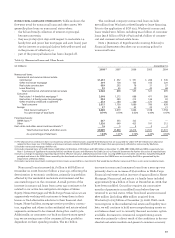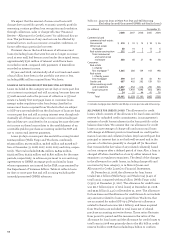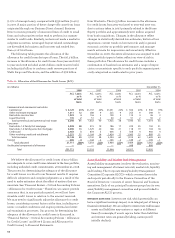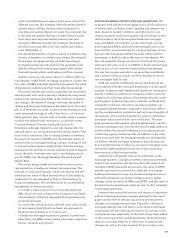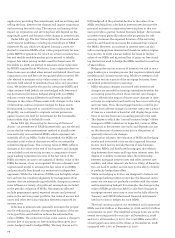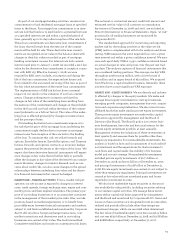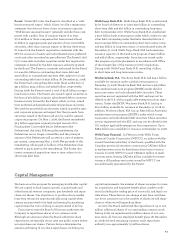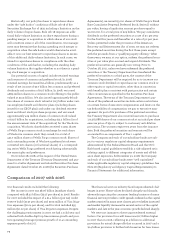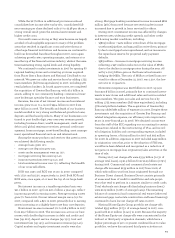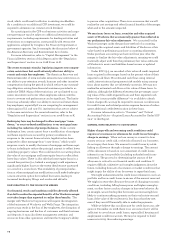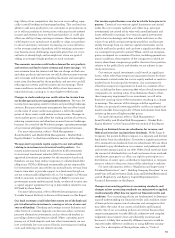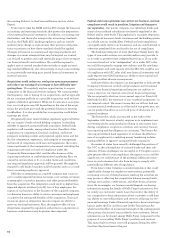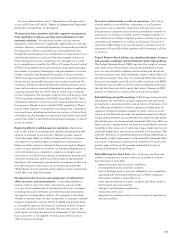Wells Fargo 2008 Annual Report Download - page 75
Download and view the complete annual report
Please find page 75 of the 2008 Wells Fargo annual report below. You can navigate through the pages in the report by either clicking on the pages listed below, or by using the keyword search tool below to find specific information within the annual report.
Parent. Under SEC rules, the Parent is classified as a “well-
known seasoned issuer,” which allows it to file a registration
statement that does not have a limit on issuance capacity.
“Well-known seasoned issuers” generally include those com-
panies with a public float of common equity of at least
$700 million or those companies that have issued at least
$1 billion in aggregate principal amount of non-convertible
securities, other than common equity, in the last three years.
In June 2006, the Parent’s registration statement with the
SEC for issuance of senior and subordinated notes, preferred
stock and other securities became effective. The Parent’s abil-
ity to issue debt and other securities under this registration
statement is limited by the debt issuance authority granted
by the Board. The Parent is currently authorized by the Board
to issue $60 billion in outstanding short-term debt and
$170 billion in outstanding long-term debt, subject to a total
outstanding debt limit of $230 billion. At December 31, 2008,
the Parent had outstanding debt under these authorities of
$31.9 billion, $133.1 billion and $165.8 billion, respectively.
During 2008, the Parent issued a total of $12.8 billion in regis-
tered senior notes. The Parent also issued capital securities in
the form of $6.5 billion in junior subordinated debt to statutory
business trusts formed by the Parent, which, in turn, issued
trust preferred and perpetual preferred purchase securities.
We used the proceeds from securities issued in 2008 for gen-
eral corporate purposes and expect that the proceeds from
securities issued in the future will also be used for general
corporate purposes. On May 1, 2008, the Parent remarketed
$2.9 billion aggregate original principal amount of its
Floating Rate Convertible Senior Debentures (the
Debentures) due 2033. Following the remarketing, the
Debentures are no longer convertible, and the principal
amount of the Debentures will accrete at a rate of 3.55175%
per annum, commencing May 1, 2008. Net proceeds of the
remarketing will be paid to holders of the Debentures that
elected to participate in the remarketing. The Parent also
issues commercial paper from time to time, subject to its
short-term debt limit.
Wells Fargo Bank, N.A. Wells Fargo Bank, N.A. is authorized
by its board of directors to issue $100 billion in outstanding
short-term debt and $50 billion in outstanding long-term
debt. In December 2007, Wells Fargo Bank, N.A. established
a $100 billion bank note program under which, subject to any
other debt outstanding under the limits described above, it
may issue $50 billion in outstanding short-term senior notes
and $50 billion in long-term senior or subordinated notes. At
December 31, 2008, Wells Fargo Bank, N.A. had remaining
issuance capacity on the bank note program of $49.0 billion
and $48.4 billion, respectively. Securities are issued under
this program as private placements in accordance with Office
of the Comptroller of the Currency (OCC) regulations.
During 2008, Wells Fargo Bank, N.A. issued $43.1 billion
in short-term and long-term senior notes.
Wachovia Bank, N.A. Wachovia Bank, N.A. had $49.0 billion
available for issuance under a global note program at
December 31, 2008. Wachovia Bank, N.A. also has a $25 billion
Euro medium-term note program (EMTN) under which it
may issue senior and subordinated debt securities. These
securities are not registered with the SEC and may not be
offered in the U.S. without applicable exemptions from regis-
tration. Under the EMTN, Wachovia Bank, N.A. had up to
$22.4 billion available for issuance at December 31, 2008. In
addition, Wachovia Bank, N.A. has an A$10 billion Australian
medium-term note program (AMTN), under which it may
issue senior and subordinated debt securities. These securities
are not registered with the SEC and may not be offered in the
U.S. without applicable exemptions from registration. Up to
A$8.5 billion was available for issuance at December 31, 2008.
Wells Fargo Financial. In February 2008, Wells Fargo
Financial Canada Corporation (WFFCC), an indirect wholly-
owned Canadian subsidiary of the Parent, qualified with the
Canadian provincial securities commissions CAD$7.0 billion
in medium-term notes for distribution from time to time in
Canada. In 2008, WFFCC issued CAD$500 million in medi-
um-term notes, leaving CAD$6.5 billion available for future
issuance. All medium-term notes issued by WFFCC are
unconditionally guaranteed by the Parent.
Capital Management
We have an active program for managing stockholder capital.
We use capital to fund organic growth, acquire banks and
other financial services companies, pay dividends and repur-
chase our shares. Our objective is to produce above-market
long-term returns by opportunistically using capital when
returns are perceived to be high and issuing/accumulating
capital when the costs of doing so are perceived to be low.
From time to time the Board of Directors authorizes the
Company to repurchase shares of our common stock.
Although we announce when the Board authorizes share
repurchases, we typically do not give any public notice before
we repurchase our shares. Various factors determine the
amount and timing of our share repurchases, including our
capital requirements, the number of shares we expect to issue
for acquisitions and employee benefit plans, market condi-
tions (including the trading price of our stock), and legal con-
siderations. These factors can change at any time, and there
can be no assurance as to the number of shares we will repur-
chase or when we will repurchase them.
In 2007, the Board authorized the repurchase of up to 200
million additional shares of our outstanding common stock.
During 2008, we repurchased 52 million shares of our com-
mon stock, all from our employee benefit plans. At December
31, 2008, the total remaining common stock repurchase
authority was approximately 15 million shares.




